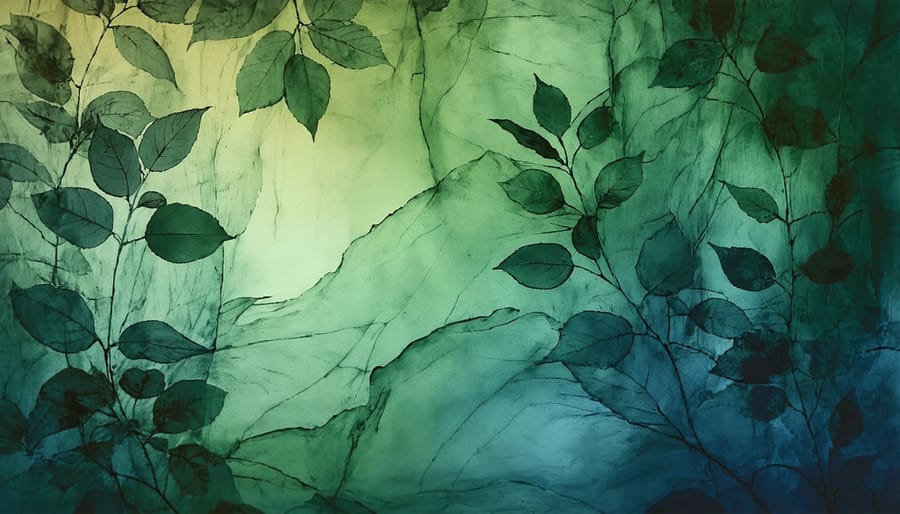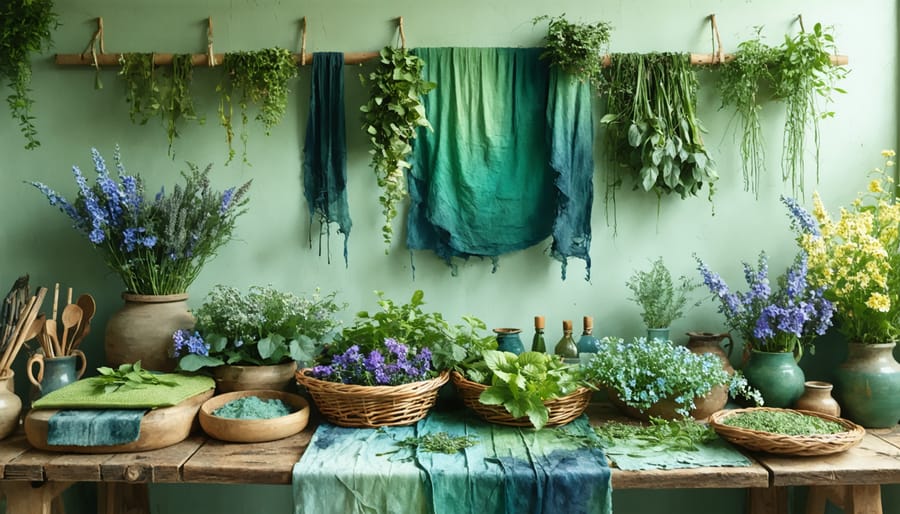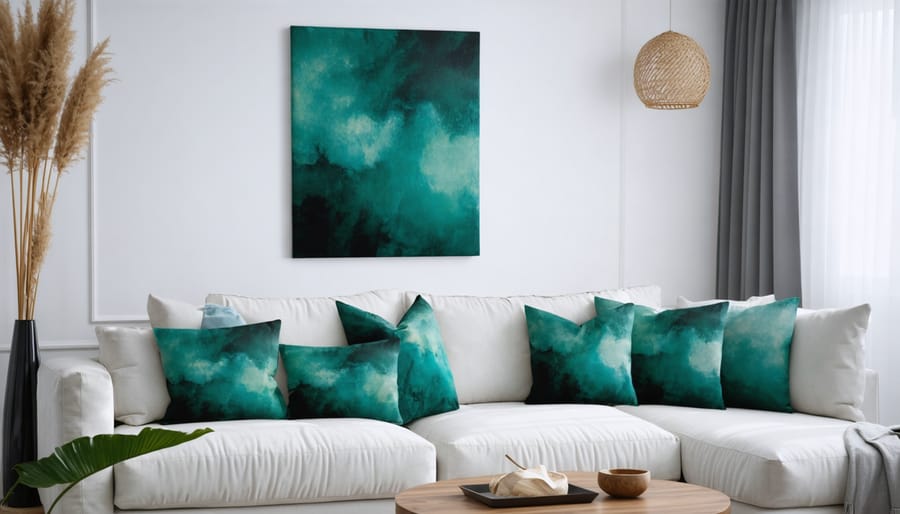Transform your living spaces with the timeless beauty of eco-dyed fabrics, where natural pigments and botanical elements create unique, sustainable textiles that elevate artisan craftsmanship in home decor. This gentle dyeing process harnesses the power of leaves, flowers, and bark to imprint intricate patterns and rich hues onto natural fibers, creating one-of-a-kind pieces that tell a story of environmental consciousness and artistic expression. Unlike conventional dyeing methods, eco-dyeing celebrates the unpredictable beauty of nature, producing subtle variations and organic patterns that cannot be replicated by synthetic processes. Whether you’re looking to craft your own sustainable textiles or incorporate these environmentally friendly fabrics into your home’s design scheme, eco-dyed materials offer a perfect blend of aesthetic appeal and ecological responsibility, bringing the raw beauty of nature directly into your living space.
What Makes Eco Dyeing Special for Your Home
Sustainable Beauty in Every Fiber
The magic of eco dyeing lies in its ability to create one-of-a-kind patterns that tell a story through nature’s palette. Each piece becomes an artistic expression, perfect for contemporary home accents that bring organic beauty indoors. When leaves, flowers, and botanical materials are pressed against fabric and steamed or simmered, they release their natural pigments and shapes, creating stunning impressions that can never be exactly replicated.
The process captures nature’s intricate details – the delicate veining of leaves, the subtle gradients of flower petals, and the rich variations in plant material create depth and dimension in the fabric. Colors range from soft, earthy browns and greens to vibrant yellows and deep purples, depending on the plants used and the mordants applied. Each season brings different botanical possibilities, making eco dyeing a year-round adventure in color exploration.
What makes these patterns truly special is their organic, almost watercolor-like quality. The edges blur and blend naturally, creating sophisticated designs that feel both wild and intentional. No two pieces are ever identical, ensuring that your eco-dyed creations remain uniquely yours.

Earth-Friendly Color Creation
When you choose eco-dyeing over synthetic alternatives, you’re making a significant positive impact on our environment. Natural dyes derived from plants, flowers, and food waste create zero toxic runoff and are completely biodegradable. Unlike synthetic dyes that often contain harmful chemicals and heavy metals, these earth-friendly pigments break down naturally without harming soil or water systems.
The process of eco-dyeing uses considerably less water than conventional dyeing methods, and the water used can be safely recycled in your garden. Many natural dye materials come from kitchen scraps like onion skins, avocado pits, and vegetable trimmings that would otherwise end up in landfills. You’re essentially turning waste into beauty!
Plus, working with natural dyes means you’re not exposing yourself or your home to harsh chemicals. The gentle process creates unique, organic patterns and colors that synthetic dyes simply can’t replicate. While natural dyes might require more patience to achieve desired results, the environmental benefits and distinctive aesthetic make the extra effort worthwhile.
Natural Materials for Beautiful Results
Best Plants and Flowers for Home Dyeing
Your backyard and local environment are treasure troves of natural dye materials! Let’s explore some of the best plants and flowers you can use for eco-dyeing fabric at home.
Onion skins are a fantastic starting point, producing beautiful golden and bronze hues. Save both red and yellow onion skins – they’re free and readily available. Avocado pits and skins might surprise you with their lovely pink tones, while blackberries and blueberries create stunning purple shades.
For yellow dyes, try marigolds, dandelions, and turmeric root. These materials are easy to grow or source and provide reliable results. Indigo plants offer classic blue shades, though they require more preparation. Red cabbage creates lovely lavender hues, while eucalyptus leaves imprint beautiful patterns and colors.
Pro tip: Create a dye garden by planting cosmos, coreopsis, and calendula – all excellent dye sources that are also beautiful additions to your landscape. Don’t forget about common kitchen ingredients like coffee grounds and tea bags, which produce lovely earth tones.
When foraging, always ensure you have permission and identify plants correctly. The best time to harvest most flowers is in the morning after the dew has dried but before the heat of the day. Store dried materials in paper bags in a cool, dark place until you’re ready to use them.
Remember that natural dyes often produce softer, more muted tones than synthetic alternatives – that’s part of their charm and what makes each piece unique.
Choosing Your Fabric Canvas
Selecting the right fabric for eco dyeing is crucial for achieving beautiful, long-lasting results. Natural fibers are your best friends in this creative journey, with cotton, silk, and wool being the top choices. These materials readily accept plant-based dyes and create stunning patterns that synthetic fabrics simply can’t match.
Cotton is perfect for beginners – it’s affordable, easy to work with, and produces lovely earthy tones. Look for unbleached, organic cotton for the most authentic results. Silk, while more expensive, creates incredibly vibrant prints and accepts dyes beautifully, making it ideal for special projects or wearable art pieces. Wool fabric and felt also work wonderfully, producing rich, deep colors that often exceed expectations.
Before starting, always pre-wash your fabric to remove any sizing or chemicals that might interfere with the dyeing process. Light-colored or white fabrics work best, as they provide a clean canvas for your natural dyes to shine. The weight of your fabric matters too – medium-weight materials are generally easier to handle than very light or heavy options.
Pro tip: Start with small fabric samples to test different combinations before committing to larger pieces. This way, you can experiment freely and develop a good understanding of how different fabrics react to your chosen dye materials.
DIY Eco Dyeing: Your First Project
Setting Up Your Dye Space
Before diving into eco-dying, it’s essential to set up a dedicated workspace that’s both safe and efficient. Choose a well-ventilated area, ideally with access to running water and natural light. Your kitchen or garage can work perfectly, but remember to protect all surfaces with plastic sheets or old newspapers.
Gather your basic supplies: large pots (dedicated only to dyeing), wooden spoons, rubber gloves, protective apron, and face mask. You’ll also need a heat source – a stovetop or portable burner works well. Set up separate areas for preparing materials, dyeing, and drying to maintain an organized workflow.
Safety should be your top priority. Keep children and pets away from your workspace, and never use cooking utensils or pots that you plan to use for food later. Have a first aid kit nearby, and ensure proper ventilation when working with hot water and plant materials.
Create a designated drying space by setting up a clothesline or drying rack in a well-ventilated area away from direct sunlight. This will help your fabrics dry evenly and maintain their beautiful colors.

The Dyeing Process
Creating eco dyed fabric is a rewarding process that brings nature’s beauty directly into your textiles. Here’s how to get started with your own eco dyeing project:
Begin by gathering your materials: natural white or cream-colored fabric (100% natural fibers work best), plants or flowers, vinegar, and basic tools like rubber bands and a large pot. Pre-wash your fabric to remove any sizing or residues that might interfere with the dye process.
Create a mordant bath by mixing one part vinegar with four parts water. Soak your fabric in this solution for at least an hour – this helps the natural dyes bond with the fibers. While waiting, collect your plant materials. Leaves, flowers, and bark work wonderfully, with eucalyptus, maple leaves, and rose petals being popular choices.
Layer your damp fabric with the selected plant materials, being mindful of placement. Roll the fabric tightly around a wooden dowel or simply bundle it together, securing with string or rubber bands. The tighter you bundle, the more defined your prints will be.
Place your bundle in a large pot and cover with water. Bring to a gentle simmer and maintain this temperature for about an hour. Some dyers prefer to steam their bundles instead, which can produce sharper prints.
Allow your bundle to cool completely before unwrapping – this is crucial for color development. Once cooled, carefully unwrap your fabric to reveal the unique patterns. Let it dry naturally, then heat-set the dyes by ironing on medium heat.
Pro tip: Keep a dyeing journal to record which plants created which colors and patterns. This helps you replicate successful results and learn from each project. Remember that natural dyeing is both an art and an experiment – embrace the unpredictable beauty of each piece you create.
Finishing and Care Tips
To ensure your eco-dyed fabrics maintain their beauty and last longer, proper finishing and care are essential. Start by heat-setting your dyed fabric with an iron on medium heat for 3-5 minutes, pressing firmly across the entire surface. For best results, place a clean cloth between the iron and your dyed fabric.
After heat-setting, let your fabric rest for 24 hours before washing. For the first wash, use cold water and a gentle, pH-neutral detergent to prevent color bleeding. Avoid harsh detergents or bleach, as these can fade your natural dyes. Hand washing is ideal, but if using a machine, select the gentle cycle and wash similar colors together.
To maintain the vibrancy of your eco-dyed fabrics, store them away from direct sunlight when not in use. If hanging them as decor, consider rotating their position periodically to prevent uneven fading. For delicate pieces, dry cleaning may be the safest option.
Remember that natural dyes may gradually fade over time – this is part of their organic charm. Regular gentle care and proper storage will help preserve their unique patterns and colors for years to come.
Creative Ways to Use Eco Dyed Fabrics

Statement Pieces and Accents
Eco dyed fabrics can become stunning focal points in your home, seamlessly blending natural beauty with modern design elements. Consider creating an eye-catching wall hanging using a large piece of eco dyed silk, allowing the organic patterns to serve as natural artwork. The unique, unrepeatable designs make excellent conversation starters and instantly elevate any room’s aesthetic.
Transform your living space by incorporating eco dyed fabric throw pillows in varying sizes and patterns. The subtle variations in color and design create depth and visual interest while maintaining a cohesive look. For a bold statement, upholster an accent chair or ottoman with your eco dyed creation – the natural patterns will turn ordinary furniture into an artistic centerpiece.
Window treatments offer another opportunity to showcase these beautiful textiles. Light filtering through eco dyed curtains creates an enchanting play of colors and shadows throughout the day. Consider using smaller pieces as table runners or framed textile art for more subtle accents that still make an impact.
In the bedroom, an eco dyed headboard cover or decorative wall tapestry can transform the entire space. For a more portable option, create throw blankets that can be draped over furniture or used as wall hangings, allowing you to easily refresh your decor whenever the mood strikes.
Practical Applications
Eco dyed fabrics offer endless possibilities for bringing natural beauty into your home. These unique textiles can transform living spaces with their one-of-a-kind patterns and earthy color palettes.
One of the most popular applications is creating stunning throw pillows that add organic charm to sofas and beds. Table runners and placemats made from eco dyed fabric bring a touch of nature to your dining area, while custom curtains can filter light through their beautiful botanical prints.
In the bedroom, eco dyed fabric shines in duvet covers, pillowcases, and decorative wall hangings. The subtle variations in color and pattern create a calming atmosphere perfect for rest and relaxation. Consider framing smaller pieces as artwork or creating a gallery wall of different eco dyed samples.
For practical everyday items, eco dyed fabric makes beautiful tea towels, napkins, and cloth bags for shopping or storage. These pieces are not only environmentally friendly but also become more characterful with use. You can even use eco dyed fabric to recover lamp shades, create book covers, or fashion unique gift wrap for special occasions.
The beauty of eco dyed textiles lies in their versatility – each piece tells its own story while complementing various decorating styles, from bohemian to minimalist modern.
Eco dyeing fabric offers a wonderful opportunity to create unique, environmentally friendly textiles while connecting with nature in a meaningful way. The process not only produces beautiful, one-of-a-kind pieces but also reduces our environmental impact by using natural materials and avoiding harsh chemicals. Whether you’re creating curtains, throw pillows, or wearable art, eco dyeing allows you to express your creativity while staying true to sustainable principles.
By experimenting with different leaves, flowers, and mordants, you’ll discover endless possibilities for creating stunning patterns and colors. The satisfaction of transforming plain fabric into beautiful art using materials from your own garden or local environment is truly unmatched. We encourage you to gather your materials, embrace the experimental nature of the process, and start your eco dyeing journey today. Remember, each piece will be uniquely yours, telling its own story through natural colors and patterns.
